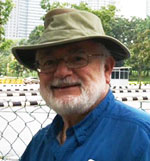The Librarian of Auschwitz by Antonio Iturbe, translated by Lilit Thwaites,Godwin Books, Henry Holt and Co., New York, $19.99, 424 pages.
By Oliver B. Pollak

RICHMOND, California — This story, set in Prague, Theresienstadt, Auschwitz, Hamburg, and Tel Aviv, is creative non-fiction. It appeared in Spanish in 2012 and was translated into English in 2017. The author found his subject by a lead in Alberto Manguel’s The Library at Night, published in Spanish in 2005. It “was the point of departure for my journalistic investigation, which gave rise to this book.”
He fills his story with dialogue, narrative, emotions, and romance, within the context of facts we know. Dita is a 14-year-old Czech girl whose mission is to preserve eight books in the concentration camp. Discerning between the real and literary fantasy approaches the wiki word “disambiguation.” A good read is not the same as the truth. Non-fiction may be more difficult to read, swallow and digest. But do you want the real thing, a placebo, or worse the Wilkomirski’s 1996 travesty Fragments: memories of a wartime childhood.
Reviews are a good place to start determining a book’s bona fides. The attractiveness of a title may cause one to leap frog protocol, rely on impulse and intuition; buy first, and investigate later. Professional reviews, not lay reader reviews, establish a book’s credibility. Nadine Wojakovski in England’s online JCNews of January 26, 2018, categorized The Librarian of Auschwitz as a “semi-fictionalised version of Dita’s story.” The librarian Dita married another survivor, Ota Kraus, and moved to Israel in 1949. Dita Kraus is now 88 and lives in Tel Aviv with, and health permitting, annual visits to Prague. In an interview she attributed her survival to the inexplicable: “Perhaps an initial good constitution and luck, luck, and again luck.”
How early in the book should the distinction of truth and fiction be disclosed? Dust jackets are a good place to start: “Based on the experiences of real-life Auschwitz prisoner Dita Kraus, this is the incredible story of a girl who risked her life to keep the magic of books alive during the Holocaust.” This is seriously qualified by the Postscript on page 408. But who reads the postscript before reading the book. Prologue and Introduction would be better disclosure locations. The Postscript stated in the third line, “The bricks used to construct this story are facts, and they are held together in these pages with a mortar of fiction.” Iturbe observes “Sometimes, narrative fiction reveals truths that can’t be told any other way.”
Jews in particular are fascinated by the genre of texts about texts, books about books. It’s in the blood, or DNA, ‘people of the book,’ not uniquely Jewish, has recently been joined by ‘the prosen people.’ Jewish devotion and reliance on the written word’s survival may dates back to the Torah.
A short list of the genre of life story built around a diary or a book written by Jews and non-Jews, include the Diary of Anne Frank, Canticle for Leibowitz (1959) by William M. Miller, Jr., The Reader (1995) by Bernhard Schlink, Outwitting History, The amazing adventures of a man who rescued a million Yiddish books (2005) by Aaron Lansky, The Book Thief (2005) by Markus Zusak, and People of the Book (2008) by Geraldine Brooks, and most recently, The Weight of Ink (2017) by Rachel Kadish. Book sellers cross merchandise these titles and suggest further titles, ‘people who looked at this book, also looked at.’
There are at least three works on reading in extremis, Hunger for the Printed Word: Books and Libraries in Jewish Ghettos of Nazi-Occupied Europe (1997) by David Shavit, The Holocaust and the Book: destruction and preservation (2001) by Jonathan Rose, and Andrew Wertheimer’s doctoral dissertation, “Japanese American Community Libraries in America’s Concentration Camps, 1942-1946” (2004).
I’m not a fan of historical novels. Creative non-fiction disturbs my sense of the known merging with the imagined. Despite misgivings about this genre, and the potential for trivializing the subject, the dialogue between fiction and non-fiction clarifies values.
Despite the above caveats I read the book cover to cover. Dita was the librarian of eight hidden books in Auschwitz. She idolized the Jewish camp leader but the teenager was disillusioned when she found out he was gay, and the more so when it appeared he committed suicide. Her Family concentration camp unit filled with children and teachers was a pawn in Nazi anticipation of visiting international human rights inspectors, similar to sprucing up Theresienstadt for the Red Cross. The Auschwitz visit never happened and the camp was liquidated. Her father died in the camp, and her mother a few days after liberation. She left the camp an orphan. Today her Tel Aviv living room is lined with bookshelves filled with books.
*
Pollak, an attorney and professor emeritus of history at the University of Nebraska Omaha, is a SDJW correspondent now based in Richmond, California. He may be contacted via oliver.pollak@sdjewishworld.com